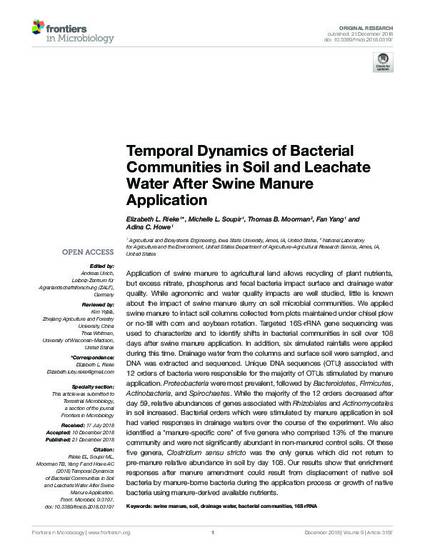
Application of swine manure to agricultural land allows recycling of plant nutrients, but excess nitrate, phosphorus and fecal bacteria impact surface and drainage water quality. While agronomic and water quality impacts are well studied, little is known about the impact of swine manure slurry on soil microbial communities. We applied swine manure to intact soil columns collected from plots maintained under chisel plow or no-till with corn and soybean rotation. Targeted 16S-rRNA gene sequencing was used to characterize and to identify shifts in bacterial communities in soil over 108 days after swine manure application. In addition, six simulated rainfalls were applied during this time. Drainage water from the columns and surface soil were sampled, and DNA was extracted and sequenced. Unique DNA sequences (OTU) associated with 12 orders of bacteria were responsible for the majority of OTUs stimulated by manure application. Proteobacteria were most prevalent, followed by Bacteroidetes, Firmicutes, Actinobacteria, and Spirochaetes. While the majority of the 12 orders decreased after day 59, relative abundances of genes associated with Rhizobiales and Actinomycetales in soil increased. Bacterial orders which were stimulated by manure application in soil had varied responses in drainage waters over the course of the experiment. We also identified a “manure-specific core” of five genera who comprised 13% of the manure community and were not significantly abundant in non-manured control soils. Of these five genera, Clostridium sensu stricto was the only genus which did not return to pre-manure relative abundance in soil by day 108. Our results show that enrichment responses after manure amendment could result from displacement of native soil bacteria by manure-borne bacteria during the application process or growth of native bacteria using manure-derived available nutrients.
Available at: http://works.bepress.com/adina/36/

This article is published as Rieke, Elizabeth Luby, Michelle Lynn Soupir, Thomas B. Moorman, Fan Yang, and Adina Chuang Howe. "Temporal dynamics of bacterial communities in soil and leachate water after swine manure application." Frontiers in Microbiology 9 (2018): 3197. DOI: 10.3389/fmicb.2018.03197.